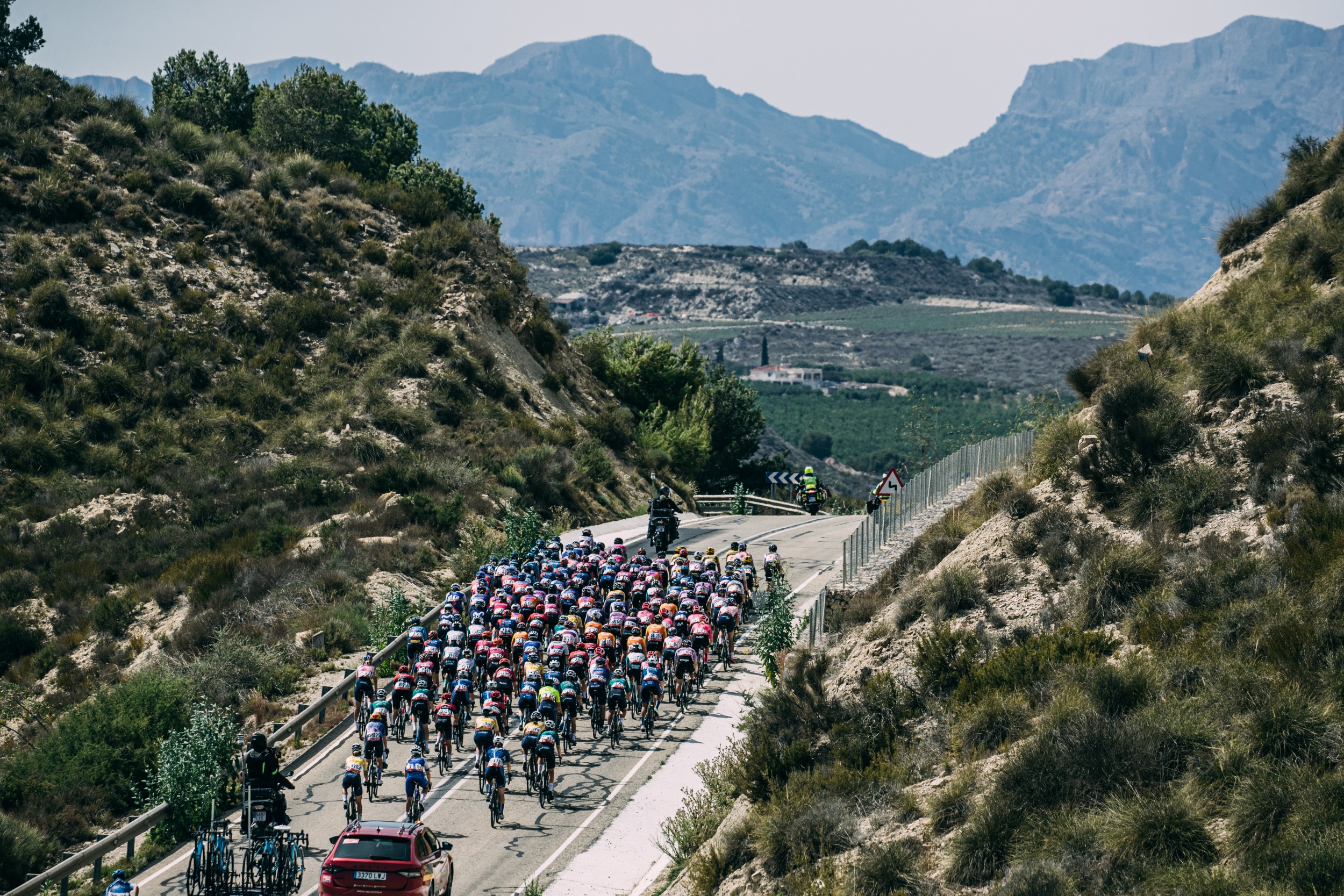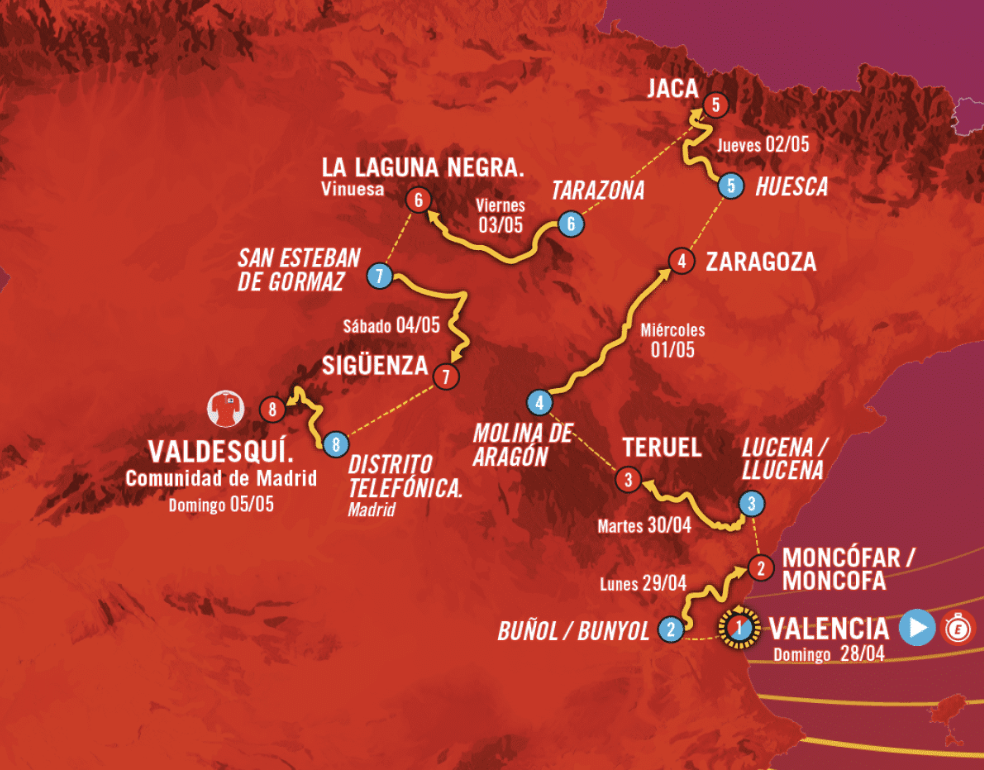

Get ready for an exhilarating edition of the La Vuelta Femenina by Carrefour.es, the premier women’s cycling event in Spain. This year’s route presents an alluring mix of terrain that will challenge the riders’ versatility and stamina. Here’s an in-depth look at each stage, highlighting the challenges and expectations that will shape this year’s race.
History of La Vuelta Femenina
The La Vuelta Femenina began in 1988 under the name “Vuelta Ciclista a España Femenina,” mirroring the men’s Vuelta a España. However, after its inaugural year, the race faced various challenges, including inconsistent organization and sponsorship difficulties, which led to its discontinuation after just a few editions. It wasn’t until 2015 that the idea of a women’s Vuelta was revived in a different format.
From 2015 to 2020, the event was held as a one-day race known as the “Madrid Challenge by La Vuelta.” This format limited the scope and competitive potential of the race but served as a crucial placeholder for women’s cycling in Spain, keeping the spirit of a women’s tour alive. In 2021, recognizing the need for greater representation and more competitive opportunities for women, the organizers expanded the race to a multi-day event, rebranding it as the Ceratizit Challenge by La Vuelta. This expansion was a significant step forward, aligning more closely with the men’s three-week Vuelta a España and providing a platform for female cyclists to showcase their endurance and skills over a variety of stages.
The expansion was not only about increasing the number of race days but also about enhancing the quality of the competition. The race was included in the UCI Women’s WorldTour, the premier calendar of women’s professional road cycling. This inclusion has attracted more top-tier teams and riders, elevating the race’s prestige and competitiveness.
Each year since its expansion, the race has added more stages, and the routes have become more diverse and challenging, featuring flat, hilly, and mountain stages, along with individual time trials. This diversity ensures that the race is a comprehensive test of a cyclist’s abilities and a worthy counterpart to the men’s tour.
The growth of La Vuelta Femenina reflects broader trends in women’s sports toward greater visibility and equality. The race not only highlights the athleticism and competitiveness of women cyclists but also serves as a platform for advocating for more substantial support and equal opportunities within the sport.
Looking to the future, the organizers continue to focus on expanding the race further, with ambitions to match the scope and scale of the men’s Vuelta a España. This growth trajectory underscores a commitment to elevating women’s
Previous winners of La Vuelta
2015 – Shelley Olds
2016 Joline d’Hoore
2017 – Jolien d’Hoore
2018 – Ellen van Dijk
2019 – Lisa Brennauer
2020 – Liss Brennauer
2021 – Annemiek van Vleuten
2022 – Annemiek van Vleuten
2023 – Annemiek van Vleuten

The Route
Stage 1: Valencia – Valencia / 16km (TTT)
This year’s team time trial will be similar to the 2023 edition but will be 1.5km longer. It’s a dead-flat, out-and-back course along wide boulevards, but with the high speeds teams will need to remain vigilant and maintain their focus at all times. Last year’s edition saw teams hitting 70kph on certain sections, with the winning team, Jumbo-Visma, averaging 48kph. Barring crashes, mechanicals, or bad weather, the time gaps shouldn’t be significant. Team time trials tend to showcase the talents of the coaching staff as much as the riders, so it’s likely that the winning team will be the one that is best prepared. “We did a really good course recon and made a good plan as a team with our race coaches.” – Anna Henderson (Jumbo-Visma).

Stage 2: Buñol/Bunyol – Moncofa / 118.5km
The day begins in red, or rather in Buñol, famous for its yearly La Tomatina festival, where attendees engage in a massive tomato fight on the last Wednesday of every August.
The peloton will begin the stage with a descent of about 15km before it hits a 45km stretch of rolling terrain that will provide an opportunity for early breakaways. At about 65km, they will begin the approach to the 3rd category climb, Puerto de l’Oronet (5.9km at 4.3%) which will likely break up the peloton. But after that it’s a long descent of 38km all the way to the finish line and any riders off the back should have plenty of time to catch up. It’s a straight run-in to the finish which should favor the sprinters. A change in the weather is in the forecast, so spring thunderstorms could play a role.

Stage 3: Lucena/Llucena – Teruel / 130.5km
Described as a mid-mountain stage with 2000 meters of “leg-breaking terrain,” this stage could prove decisive early on in the race. The major climb of the day will come at 62km, Fuente de Rubielos (6.1km at 6.2%). While the last 15km of the stage descends into Teruel, sprinters may have a difficult time staying with the peloton before that point. Early breakaways will likely have a tough time going the distance, but riders who push the pace after Fuente de Rubielos will have 45km of good rolling terrain to create a significant gap before the last 15km descent.

Stage 4: Molina de Aragón – Zaragoza / 142.5km
It’s all downhill, a 142.5km descent from 1200m to 200m. For the most part it’s a day for the fast finishers. Anyone thinking about jumping in an early break will have their work cut out for them. For the GC contenders it’s a day to relax, but they will need to stay alert for cross-winds from the Moncayo mountain range, which often gusts in the springtime.

Stage 5: Huesca – Jaca / 114km
This stage is classified as a real mountain stage, with two category 2 climbs, San Juan de la Peña at 85.5km, and Alto del Fuerte de Rapitán at the finish. The first climb, San Juan de la Peña, is not particularly steep at an average gradient of 3%, but it’s a long one at 18.5km and those who decide to force the pace could get away and gain a considerable amount of time. The final climb, Alto del Fuerte de Rapitán, is only 3.4km in length, but with a 7.9% average gradient it will very likley encourage attacks from GC rivals. Early breakaways that go from the start can possibly stay away over the first climb, but more than likely will be caught before the final climb. For the GC contenders, it’s not a day to get caught out with bad legs.

Stage 6: Tarazone – La Laguna Negra. Vinuesa / 132.5km
This stage begins with 30km of uncategorized climbing before it levels out for 80km. Wind may be a factor and GC contenders will need to stay alert until they hit the final category 1 climb, La Laguna Negra, which marks the finish. With a length of 6.6km and an average gradient of 6.8%, La Laguna Negra may prove to be decisive and those with good legs will be looking for weaknesses in their GC rivals with only one mountain stage remaining on Sunday. An early breakaway is likely to form, but a considerable gap will be needed before the final climb if it hopes to succeed. If the pace is high in the first 30km of climbing, there may be a number of riders off the back playing catch up for the entire stage.

Stage 7: San Esteban de Gormaz – Sigüenza / 139km
A lumpy stage with no major obstacles other than the final 500 meters which kicks up to 8-10%. Pure sprinters may find themselves out of their element on these steep ramps, but more explosive riders will embrace the opportunity to show themselves. GC contenders will need to watch their rivals or risk losing precious seconds in this penultimate stage. With only one stage remaining, non-GC riders will be looking for any opportunity to get in a breakaway early on or sneak away in the final kilometers. An early breakaway with the right mixture of riders could very well go the distance.

Stage 8: Distrito Telegónica – Valdesquí. Comunidad de Madrid / 89.5km
The shortest stage of the tour is guaranteed to be the most brutal and entertaining, with two category 1 climbs, the Morcuera Pass and the Cotos Pass, for a total of 2,187 meters of elevation. The first 12km of the stage is flat, followed by 15km of uncategorized climbing, then a descent of 6km before the first climb begins, Puerto de la Morcuera (9.1km, 6.8%). After this climb, there’s another descent of about 15km before the final climb (12.8km at 4.8%) begins up to Valdesquí ski resort. We may see the top GC contenders sticking together until the final climb, but anything can happen in the 2.5 hours of racing. It’s very unlikely that an early breakaway will be able to stay away on such a short and demanding stage.

Riders to watch:
Demi Vollering (SD Worx-Protime) is still considered the favorite for this year’s race, even if her Spring Classics campaign wasn’t quite on par with the previous year. Forgetting that she achieved four podium spots recently in the Spring Classics – Strade Bianche Donne (3rd), De Brabantse Pijl (2nd), La Flèche Wallonne Femmes (2nd), and Liège-Bastogne-Liège Femmes (3rd) – would be a grave error. One must also keep in mind that Vollering only lost the 2023 edition of this race to Annemiek van Vleuten by nine seconds due to poor judgment – her stopping for a nature break. While there has been press chatter that Vollering has been distracted this season and might be lacking form or confidence, she’s still the reigning Tour de France Femmes avec Zwift champ, and still comes out on top of all the other GC contenders.
Kasia Niewiadoma (Canyon // SRAM) is a strong contender for a top spot on the podium, especially after her impressive showing at the Spring Classics where she outpowered Vollering on the steep ramps of Mur de Huy at La Flèche Wallonne Femmes. She’s had a very consistent spring with four top 5 placings and appears to be in the form of her life right now. As a two-time podium finisher at the Tour de France Femmes avec Zwift, Niewiadoma also has the talent and experience to perform well in stage races longer than a few days. However, she does have a tendency to rely too much on her physical abilities. That said, her most recent races suggest that she has refined her approach to racing and has become more savvy with attacks and tactics. If she keeps the form she’s had recently, she may turn out to be Vollering’s greatest threat.
Gaia Realini (Lidl-Trek) is at age 22 one of the best climbers in the peloton and could do very well in this year’s mountainous La Vuelta Femenina. Last year, Realini put in an impressive performance by beating Annemiek van Vleuten on stage six and placing second behind Vollering on stage seven. In doing so, she moved up eighteen places on the GC into third spot and won the mountain jersey. While this year’s course is to her advantage, Realini, who weighs only 40kg, will still need to be careful in the flat and windy stages, like last year’s stage 3, where she was caught out in a cross-wind and lost time in the GC. Even though she didn’t perform so well this spring compared to last year, expect to see Realini battling it out with other GC contenders, especially in the mountains.
Elisa Longo Borghini (Lidl-Trek) has been in great form this spring, finishing on the podium no less than seven times. In Liège-Bastogne-Liège Femmes and La Flèche Wallonne Femmes she looked very impressive on the climbs, however, it’s questionable whether this year’s mountains in La Vuelta Femenina will suit her. If they don’t, then she will probably put her efforts into supporting her teammate Gaia Realini and hunt for stage victories. Always a great tactician, Longo Borghini was second at this race in 2022 and could prove instrumental in helping Realini stay out of trouble and challenge GC rivals.
Other riders to follow:
Ricarda Bauernfeind (Canyon//SRAM) was fifth in last year’s race and ninth in the GC at last year’s Tour de France Femmes avec Zwift. However, her most significant performance may be her stage 5 win at last year’s TdFFZ where she soloed to victory ahead of the peloton. In last year’s final mountain stage of La Vuelta Femenina she placed fifth and showed she has the potential to climb. At age 24, she is still developing as a rider and discovering her strengths. Whether she can climb onto the podium will be a question of how well she handles the mountains this year.
Juliette Labous (dsm-firmenich PostNL) was seventh in last year’s edition, second at the 2023 Giro d’Italia Donne, and fifth at the 2023 Tour de France Femmes avec Zwift. Along with those achievements, she placed fifth on the demanding Col du Tourmalet stage in last year’s TdFFZ, only a handful of seconds behind Annemiek van Vleuten. At age 25, Labous is still developing as a Grand Tour rider, but with some luck and good legs in the mountains, she could find herself on the podium at this year’s La Vuelta Femenina.
Riejanne Markus (Visma | Lease a Bike) was fourth in last year’s edition and showed herself capable in the mountains, but this year’s high mountains may not suit her as well. As a strong time trialist, Markus might be able to gain more of an advantage in the flatter stages, rather than in the high mountains. A podium spot may be possible if conditons force the GC climbers to lose time.